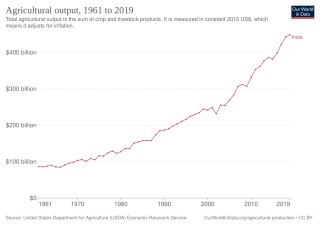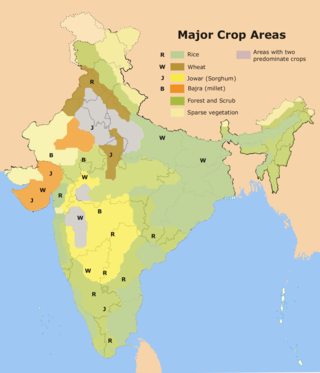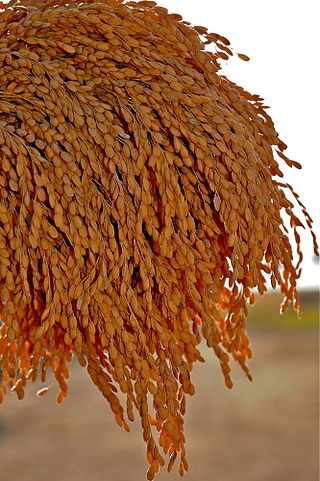
Rice is the seed of the grass species Oryza sativa or, much less commonly, O. glaberrima. As a cereal grain, domesticated rice is the most widely consumed staple food for over half of the world's human population, particularly in Asia and Africa. It is the agricultural commodity with the third-highest worldwide production, after sugarcane and maize. Since sizable portions of sugarcane and maize crops are used for purposes other than human consumption, rice is the most important food crop with regard to human nutrition and caloric intake, providing more than one-fifth of the calories consumed worldwide by humans. There are many varieties of rice, and culinary preferences tend to vary regionally.

Eleusine coracana, or finger millet is an annual herbaceous plant widely grown as a cereal crop in the arid and semiarid areas in Africa and Asia. It is a tetraploid and self-pollinating species probably evolved from its wild relative Eleusine africana.

The mung bean, alternatively known as the green gram, maash ٫ mūng, monggo, đậu xanh, pesalu, kacang hijau or munggo (Philippines), is a plant species in the legume family. The mung bean is mainly cultivated in East, Southeast and South Asia. It is used as an ingredient in both savoury and sweet dishes.

The System of Rice Intensification (SRI) is a farming methodology that aims to increase the yield of rice while using fewer resources and reducing environmental impacts. The method was developed by a French Jesuit Father Henri de Laulanié in Madagascar and built upon decades of agricultural experimentation. SRI focuses on changing the management of plants, soil, water, and nutrients to create a more productive and sustainable system of rice cultivation.
In agriculture, the yield is a measurement of the amount of a crop grown, or product such as wool, meat or milk produced, per unit area of land. The seed ratio is another way of calculating yields.

The Centre for Cellular and Molecular Biology or CCMB is an Indian fundamental life science research establishment located in Hyderabad that operates under the aegis of the Council of Scientific and Industrial Research. CCMB is a designated "Centre of Excellence" by the Global Molecular and Cell Biology Network, UNESCO.

The history of agriculture in India dates back to the Neolithic period. India ranks second worldwide in farm outputs. As per the Indian economic survey 2020 -21, agriculture employed more than 50% of the Indian workforce and contributed 20.2% to the country's GDP.
Ambemohar is a fragrant rice variant grown in the foothills of the Western ghats region of the state of Maharashtra in India.
Hybrid rice is a type of Asian rice that has been crossbred from two very different parent varieties. As with other types of hybrids, hybrid rice typically displays heterosis or "hybrid vigor", so when grown under the same conditions as comparable purebred rice varieties, it can produce up to 30% more yield. To produce hybrid seeds in large quantity, a purebred sterile rice variety is fertilized with fertile pollen from a different variety. High-yield crops, including hybrid rice, are one of the most important tools for combatting worldwide food crises.

The Economy of Andhra Pradesh is primarily dependent on agriculture, which directly and indirectly employs 62% of the population. GSDP as per the first revised estimate, for the year 2022-23 is ₹13,17,728 crore. The state is ranked 1st in the country for the year 2021-22 in terms of the Gross State Domestic Product (GSDP) growth at constant prices with growth rate of 11.43%.

Rice production in India is an important part of the national economy.

Pusa Basmati 1121 is an independently derived Basmati rice variety, evolved through the process of hybridization over a long breeding process. This variety of basmati rice was developed by Padma Shri awardee Dr Vijaipal Singh at Indian Agricultural Research Institute (IARI), New Delhi. It was released for commercial cultivation in Kharif season of 2003 as Pusa 1121. By 2007, the variety has become widely popular with farmers, and was renamed as Pusa Basmati 1121 in 2008. It holds the world record for highest kernel elongation on cooking.

G. V. Chalam, also known as Guduru Venkata Chalam (1909–1967), was an Indian activist and agricultural scientist who received the Padma Shri in 1967.

Pakistan holds a significant position in the global rice market and is one of the leading rice-producing countries. The rice sector is crucial for the country's economy, providing livelihoods to a substantial portion of the population and contributing substantially to agricultural exports.
Indian Institute of Rice Research formerly Directorate of Rice Research or IIRR is a rice research institute located in Rajendranagar near Hyderabad, Telangana.

Farming systems in India are strategically utilized, according to the locations where they are most suitable. The farming systems that significantly contribute to the agriculture of India are subsistence farming, organic farming, industrial farming. Regions throughout India differ in types of farming they use; some are based on horticulture, ley farming, agroforestry, and many more. Due to India's geographical location, certain parts experience different climates, thus affecting each region's agricultural productivity differently. India is very dependent on its monsoon cycle for large crop yields. India's agriculture has an extensive background which goes back to at least 9 thousand years. In India, in the alluvial plains of the Indus River in Pakistan, the old cities of Mohenjo-Daro and Harappa experienced an apparent establishment of an organized farming urban culture. That society, known as the Harappan or Indus civilization, flourished until shortly after 4000 BP; it was much more comprehensive than those of Egypt or Babylonia and appeared earlier than analogous societies in northern China. Currently, the country holds the second position in agricultural production in the world. In 2007, agriculture and other industries made up more than 16% of India's GDP. Despite the steady decline in agriculture's contribution to the country's GDP, agriculture is the biggest industry in the country and plays a key role in the socio-economic growth of the country. India is the second-largest producer of wheat, rice, cotton, sugarcane, silk, groundnuts, and dozens more. It is also the second biggest harvester of vegetables and fruit, representing 8.6% and 10.9% of overall production, respectively. The major fruits produced by India are mangoes, papayas, sapota, and bananas. India also has the biggest number of livestock in the world, holding 281 million. In 2008, the country housed the second largest number of cattle in the world with 175 million.

Maratelli is a semifino rice native to the Asigliano Vercellese province of Vercelli in northern Italy. It is a stable rice genotype that maintains its features. In 1970 it covered 8% of Italian rice-cultivated fields. Maratelli rice keeps its shape better than other forms of rice during the slow cooking required for making risotto due to higher quantities of amylose.
In agriculture, grain quality depends on the use of the grain. In ethanol production, the chemical composition of grain such as starch content is important, in food and feed manufacturing, properties such as protein, oil and sugar are significant, in the milling industry, soundness is the most important factor to consider when it comes to the quality of grain. For grain farmers, high germination percentage and seed dormancy are the main features to consider. For consumers, properties such as color and flavor are most important.
Ebrahimali Abubacker Siddiq is an Indian agricultural scientist, whose research in genetics and plant breeding is reported to have assisted in the development of various high-yielding rice varieties such as dwarf basmati and hybrid rice. The government of India honoured Siddiq in 2011 with the fourth-highest civilian award of Padma Shri.












